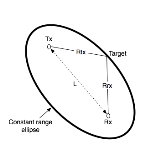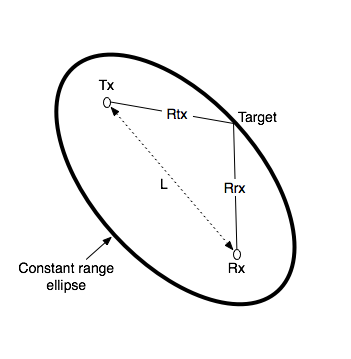
Bistatic range
Encyclopedia
Bistatic range refers to the basic measurement of range made by a radar
or sonar
system with separated transmitter and receiver. The receiver measures the time difference of arrival of the signal from the transmitter directly, and via reflection from the target. This defines an ellipse of constant bistatic range, called an iso-range contour, on which the target lies, with foci centred on the transmitter and receiver. If the target is at range Rrx from the receiver and range Rtx from the transmitter, and the receiver and transmitter are a distance L apart, then the bistatic range is Rrx+Rtx-L. Motion of the target causes a rate of change of bistatic range, which results in bistatic Doppler shift
.

Radar
Radar is an object-detection system which uses radio waves to determine the range, altitude, direction, or speed of objects. It can be used to detect aircraft, ships, spacecraft, guided missiles, motor vehicles, weather formations, and terrain. The radar dish or antenna transmits pulses of radio...
or sonar
Sonar
Sonar is a technique that uses sound propagation to navigate, communicate with or detect other vessels...
system with separated transmitter and receiver. The receiver measures the time difference of arrival of the signal from the transmitter directly, and via reflection from the target. This defines an ellipse of constant bistatic range, called an iso-range contour, on which the target lies, with foci centred on the transmitter and receiver. If the target is at range Rrx from the receiver and range Rtx from the transmitter, and the receiver and transmitter are a distance L apart, then the bistatic range is Rrx+Rtx-L. Motion of the target causes a rate of change of bistatic range, which results in bistatic Doppler shift
Bistatic Doppler shift
Bistatic Doppler shift is a specific example of the Doppler effect that is observed by a radar or sonar system with a separated transmitter and receiver. The Doppler shift is due to the component of motion of the object in the direction of the transmitter, plus the component of motion of the...
.


